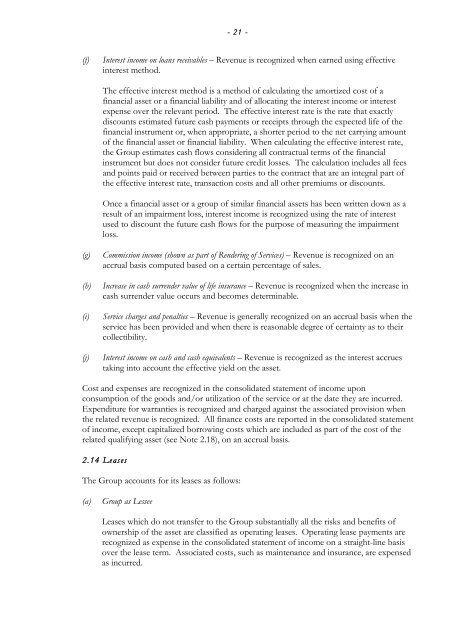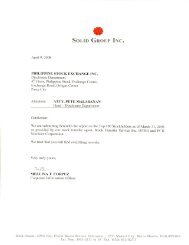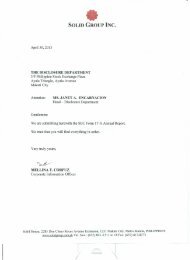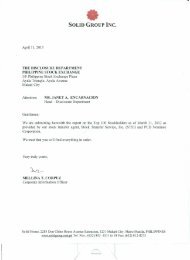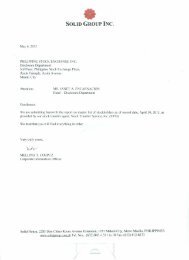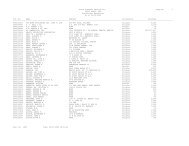2011 Annual Report - the solid group inc website
2011 Annual Report - the solid group inc website
2011 Annual Report - the solid group inc website
Create successful ePaper yourself
Turn your PDF publications into a flip-book with our unique Google optimized e-Paper software.
- 21 -<br />
(f)<br />
Interest <strong>inc</strong>ome on loans receivables – Revenue is recognized when earned using effective<br />
interest method.<br />
The effective interest method is a method of calculating <strong>the</strong> amortized cost of a<br />
financial asset or a financial liability and of allocating <strong>the</strong> interest <strong>inc</strong>ome or interest<br />
expense over <strong>the</strong> relevant period. The effective interest rate is <strong>the</strong> rate that exactly<br />
discounts estimated future cash payments or receipts through <strong>the</strong> expected life of <strong>the</strong><br />
financial instrument or, when appropriate, a shorter period to <strong>the</strong> net carrying amount<br />
of <strong>the</strong> financial asset or financial liability. When calculating <strong>the</strong> effective interest rate,<br />
<strong>the</strong> Group estimates cash flows considering all contractual terms of <strong>the</strong> financial<br />
instrument but does not consider future credit losses. The calculation <strong>inc</strong>ludes all fees<br />
and points paid or received between parties to <strong>the</strong> contract that are an integral part of<br />
<strong>the</strong> effective interest rate, transaction costs and all o<strong>the</strong>r premiums or discounts.<br />
Once a financial asset or a <strong>group</strong> of similar financial assets has been written down as a<br />
result of an impairment loss, interest <strong>inc</strong>ome is recognized using <strong>the</strong> rate of interest<br />
used to discount <strong>the</strong> future cash flows for <strong>the</strong> purpose of measuring <strong>the</strong> impairment<br />
loss.<br />
(g)<br />
(h)<br />
(i)<br />
(j)<br />
Commission <strong>inc</strong>ome (shown as part of Rendering of Services) – Revenue is recognized on an<br />
accrual basis computed based on a certain percentage of sales.<br />
Increase in cash surrender value of life insurance – Revenue is recognized when <strong>the</strong> <strong>inc</strong>rease in<br />
cash surrender value occurs and becomes determinable.<br />
Service charges and penalties – Revenue is generally recognized on an accrual basis when <strong>the</strong><br />
service has been provided and when <strong>the</strong>re is reasonable degree of certainty as to <strong>the</strong>ir<br />
collectibility.<br />
Interest <strong>inc</strong>ome on cash and cash equivalents – Revenue is recognized as <strong>the</strong> interest accrues<br />
taking into account <strong>the</strong> effective yield on <strong>the</strong> asset.<br />
Cost and expenses are recognized in <strong>the</strong> con<strong>solid</strong>ated statement of <strong>inc</strong>ome upon<br />
consumption of <strong>the</strong> goods and/or utilization of <strong>the</strong> service or at <strong>the</strong> date <strong>the</strong>y are <strong>inc</strong>urred.<br />
Expenditure for warranties is recognized and charged against <strong>the</strong> associated provision when<br />
<strong>the</strong> related revenue is recognized. All finance costs are reported in <strong>the</strong> con<strong>solid</strong>ated statement<br />
of <strong>inc</strong>ome, except capitalized borrowing costs which are <strong>inc</strong>luded as part of <strong>the</strong> cost of <strong>the</strong><br />
related qualifying asset (see Note 2.18), on an accrual basis.<br />
2.14 Leases<br />
The Group accounts for its leases as follows:<br />
(a)<br />
Group as Lessee<br />
Leases which do not transfer to <strong>the</strong> Group substantially all <strong>the</strong> risks and benefits of<br />
ownership of <strong>the</strong> asset are classified as operating leases. Operating lease payments are<br />
recognized as expense in <strong>the</strong> con<strong>solid</strong>ated statement of <strong>inc</strong>ome on a straight-line basis<br />
over <strong>the</strong> lease term. Associated costs, such as maintenance and insurance, are expensed<br />
as <strong>inc</strong>urred.


